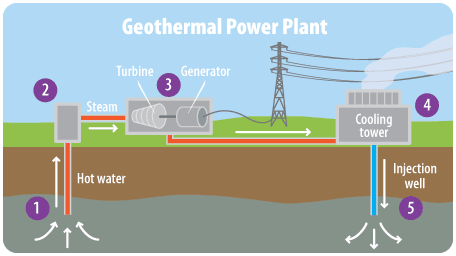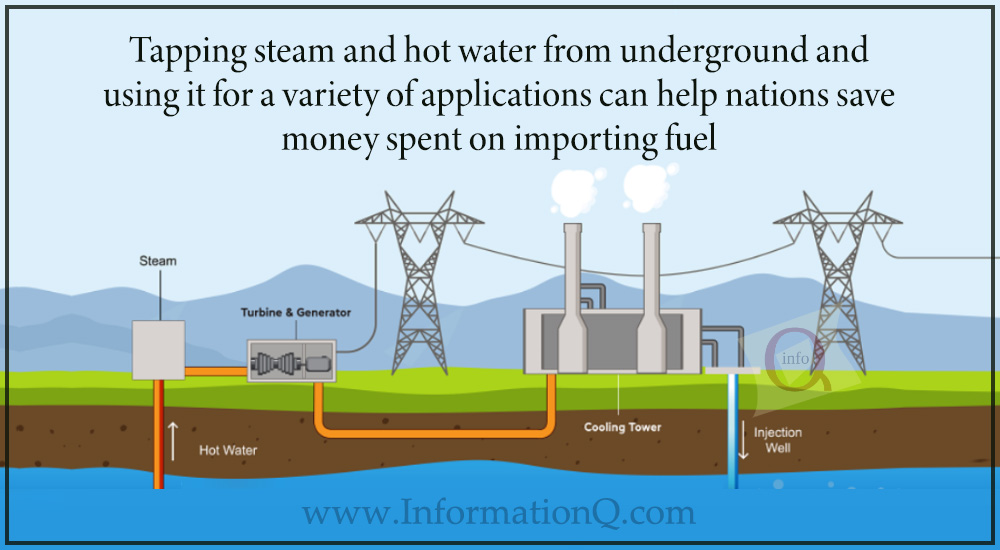Geothermal Energy Basics
In the quest for sustainable and renewable energy sources, geothermal energy has emerged as a powerful yet often underappreciated resource. Unlike solar and wind power, which rely on weather conditions, geothermal energy offers a more consistent and reliable energy solution by tapping into the Earth’s internal heat. This article will explore the fundamentals of geothermal energy, how it works, its benefits, and its role in the future of energy production.

What is Geothermal Energy?
Geothermal energy is the heat that comes from the sub-surface of the Earth. It is stored in the Earth’s core and is continuously produced by the decay of radioactive materials. This energy can be harnessed for various uses, including electricity generation, direct heating, and geothermal heat pumps.
The Earth’s Heat: Where Does It Come From?
The Earth’s core is extremely hot, with temperatures reaching over 9,000°F (5,000°C). The heat generated in the Earth’s core is continuously transferred to the surface through processes like convection, conduction, and radiation. This constant supply of heat is what makes geothermal energy a reliable and renewable resource.
Geothermal energy can be tapped into by accessing the heat beneath the Earth’s surface through wells and pipelines. In some regions, the Earth’s heat is closer to the surface, making it easier to access. These areas are often referred to as geothermal hotspots.

How Geothermal Energy Works
Geothermal energy is harnessed using a few key technologies that make it possible to convert the Earth’s heat into usable forms of energy.
1. Geothermal Power Plants
A geothermal power plant works by drilling deep into the Earth to access hot water or steam that has been naturally heated by the Earth’s internal heat. This steam or hot water is then used to power a turbine connected to a generator, producing electricity. The main types of geothermal power plants include:
- Dry Steam Plants: These plants use steam directly from the Earth to turn the turbine.
- Flash Steam Plants: These plants take hot water from the Earth and release the pressure, causing the water to flash into steam.
- Binary Cycle Plants: These plants transfer heat from geothermal hot water to another liquid, which then boils at a lower temperature to turn the turbine.
2. Geothermal Heat Pumps
Geothermal heat pumps are used for heating and cooling buildings. They work by transferring heat from the ground into the building during the winter months and reversing the process during the summer. This is done through a system of pipes buried in the ground, known as a ground loop. The heat pump then circulates the heat through a system of ducts to regulate the temperature inside the building.
3. Direct Use Applications
Geothermal energy can also be used directly for heating purposes, such as in greenhouses, fish farms, spa baths, and even district heating systems. In these systems, hot water from geothermal sources is directly pumped into buildings or facilities to provide heat.
Benefits of Geothermal Energy
Geothermal energy offers a wide range of benefits, making it one of the most promising renewable energy sources.
1. Renewable and Sustainable
Unlike fossil fuels, geothermal energy is a renewable resource. The heat from the Earth is virtually inexhaustible, making geothermal energy a reliable and sustainable energy source. It can provide a constant supply of energy as long as the Earth’s core remains hot.
2. Low Environmental Impact
Geothermal energy production has a relatively low environmental impact compared to fossil fuels. Unlike coal or natural gas, it produces minimal greenhouse gas emissions. The energy produced is clean, with no air or water pollution.
3. Baseload Power Supply
One of the greatest advantages of geothermal energy is that it can provide baseload power, meaning it operates 24/7, unlike intermittent renewable energy sources such as wind and solar. This makes it an essential component in a diversified and resilient energy grid.
4. Reduced Energy Bills
Geothermal heat pumps are a highly efficient way to heat and cool homes and buildings, often reducing energy bills by up to 70% compared to traditional heating and cooling methods. As a result, homeowners and businesses alike can save money while also reducing their carbon footprint.
5. Job Creation and Economic Growth
The geothermal energy sector is also a significant driver of job creation, especially in regions rich in geothermal resources. From drilling operations to plant management and maintenance, geothermal energy projects contribute to local economies by providing skilled labor and stimulating the job market.
Challenges of Geothermal Energy
While geothermal energy holds much promise, it is not without its challenges.
1. Geographic Limitations
Geothermal resources are not uniformly distributed around the world. The most abundant geothermal resources are located in volcanic regions or along tectonic plate boundaries. As a result, some regions have limited access to geothermal energy, making it less viable as a solution in areas that lack the necessary geology.
2. High Initial Costs
Although geothermal energy offers long-term savings, the upfront cost of installing geothermal systems—whether for power plants or heat pumps—can be quite high. Drilling wells, building infrastructure, and installing technology can require substantial investment. However, the operational and maintenance costs are generally low over time.
3. Risk of Resource Depletion
If geothermal plants are not managed properly, there is a risk of overusing the geothermal reservoir, which could lead to resource depletion. Careful monitoring and sustainable management practices are essential to ensure that geothermal systems continue to provide energy over the long term.
Geothermal Energy Around the World
Geothermal energy has been widely adopted in certain parts of the world, where natural geothermal resources are abundant. Some countries leading the way in geothermal energy production include:
- Iceland: Nearly 90% of homes in Iceland are heated using geothermal energy, and the country generates about 30% of its electricity from geothermal sources.
- United States: The U.S. is home to the largest number of geothermal power plants, with California and Nevada leading the charge.
- Philippines: The Philippines is one of the largest producers of geothermal energy in the world, generating over 20% of its electricity from geothermal sources.
- Kenya: Kenya has tapped into its geothermal resources and is rapidly expanding its geothermal capacity, making it one of the leading countries in Africa for geothermal energy.
Global Geothermal Energy Market Trends
According to the International Renewable Energy Agency (IRENA), global geothermal energy capacity is growing steadily, with countries around the world continuing to invest in geothermal energy as part of their transition to a cleaner energy mix.
FAQs About Geothermal Energy
1. How much energy does a geothermal power plant produce?
The amount of energy a geothermal power plant produces depends on the size and capacity of the plant, as well as the temperature of the geothermal resource. A single geothermal power plant can typically produce 25 to 100 megawatts of electricity, enough to power thousands of homes.
2. Is geothermal energy available everywhere?
Geothermal energy is most readily available in regions near tectonic plate boundaries or areas with volcanic activity. While it is not available everywhere, many countries with geothermal potential are investing in this resource.
3. Can geothermal energy be used for cooling?
Yes, geothermal energy is used in geothermal heat pumps to cool buildings as well as heat them. The ground temperature remains constant throughout the year, making it an effective and energy-efficient method for both heating and cooling.
4. How long does a geothermal system last?
Geothermal systems, especially geothermal heat pumps, can last for decades with proper maintenance. The average lifespan of the underground loop system is around 50 years, while the heat pump unit typically lasts about 25 years.
Conclusion
Geothermal energy represents a clean, renewable, and sustainable energy source with significant potential to reduce reliance on fossil fuels. While there are challenges related to its geographic limitations and high initial costs, the long-term benefits of geothermal energy—such as its low environmental impact and consistent power output—make it a promising solution for the future of global energy production.
By investing in geothermal technology and expanding its use worldwide, we can take a significant step toward achieving a cleaner, greener, and more sustainable energy future.


